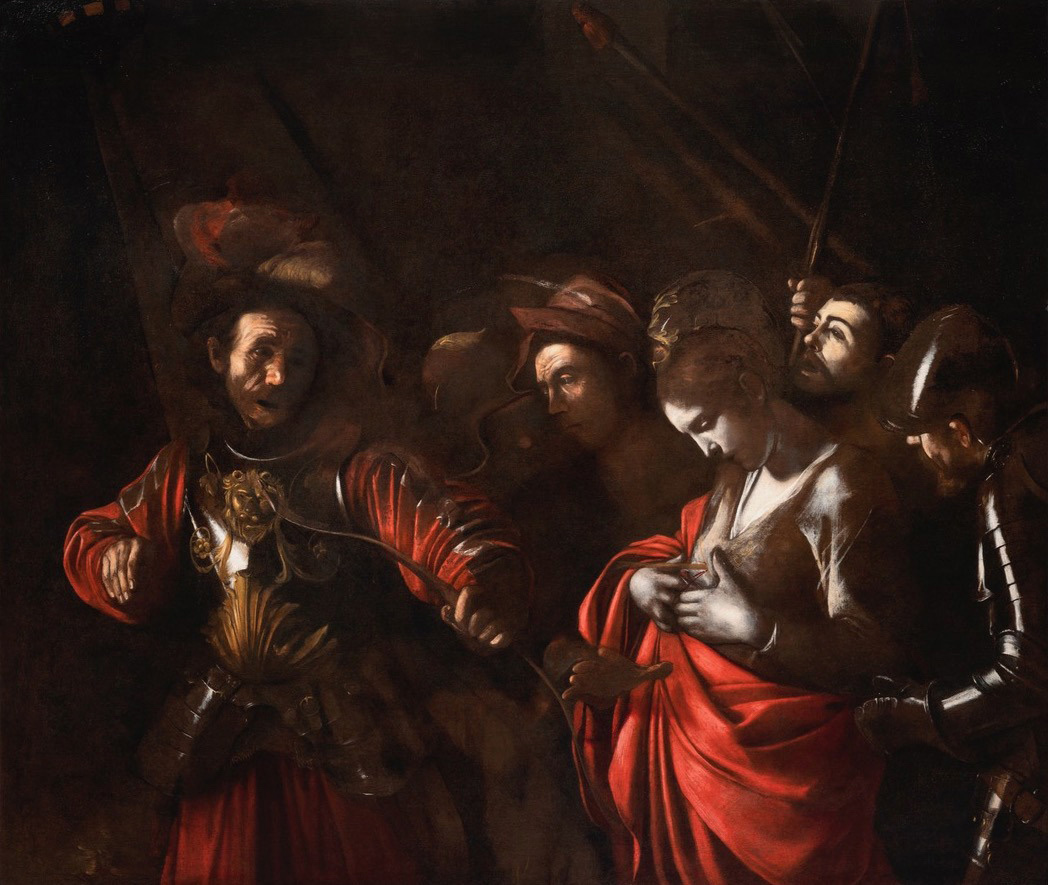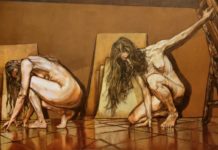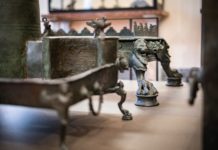La tela della vita non si comprende mentre la si intreccia,
è solo lo sguardo finale a darle un nome
Martirio di Sant’Orsola: dal primo agosto è tornato alle Gallerie d’Italia di Napoli, dopo un sorprendente restauro. Carmine Negro ne racconta la storia.
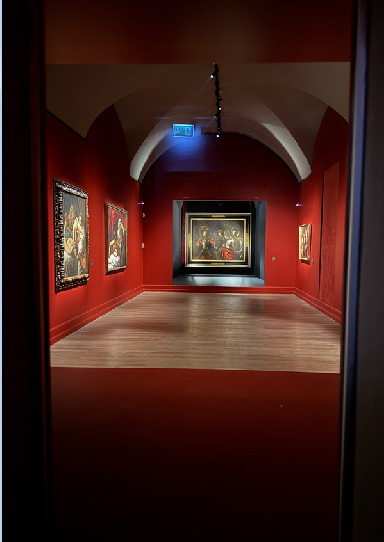
La vita è come un quadro: il suo senso si coglie solo alla fine. La piena comprensione dell’esistenza, con tutte le esperienze e il loro significato, si rivela nel tempo, soprattutto quando ci si avvicina alla conclusione. Come un dipinto, si apprezza davvero solo quando è completato e osservato nella sua interezza.
L’ultima opera di Caravaggio sembra incarnare questa riflessione, invitandoci a meditare su alcuni aspetti fondamentali.
IL FATTORE TEMPO
La vita è un processo dinamico: eventi ed esperienze si susseguono e ci trasformano. Solo con l’età si iniziano a riconoscere i legami, le lezioni apprese e il significato complessivo. Ciò che si è vissuto affiora con maggiore nitidezza nel nostro modo di agire.
Nel Martirio di sant’Orsola, il tempo, solitamente spazio di ricerca tra consapevolezza e conoscenza, appare immobile. Gli opposti — vita e morte, passato e futuro — che di norma si rincorrono nei toni freddi e caldi, qui sono cristallizzati nell’attesa di un futuro incerto. Caravaggio spera in un futuro che ricordi il passato; Orsola in una testimonianza che lo sintetizzi; il re unno in un futuro privo di memoria. Se il tempo è arte delle relazioni e la consapevolezza il loro diramarsi, qui regna un’attesa immobile, dove i protagonisti condividono il destino del loro autore.
Caravaggio rappresenta il tempo presente con straordinaria efficacia. Le sue scene sono momenti fugaci, colti nell’istante esatto del loro accadere. Non sono immagini statiche, ma sequenze che scorrono, creando un senso di realismo e contemporaneità.
Questo effetto è ottenuto attraverso:
– Luce e ombra: il chiaroscuro drammatico, crea contrasti che esaltano personaggi e azioni.
– Realismo: rompe con la tradizione accademica, dipingendo soggetti reali con espressioni e pose naturali.
– Dinamismo: le scene sono cariche di movimento e tensione, come se i personaggi fossero colti in piena azione.
– Spazio teatrale: le composizioni sembrano ambientate su un palcoscenico, con interazioni vive e coinvolgenti.
Relativamente ai tempi c’è un altro elemento che merita di esser ricordato: Caravaggio veste i suoi personaggi con abiti contemporanei: una scelta rivoluzionaria per l’epoca. Così, le sue opere diventano attuali e riconoscibili, infrangendo la tradizione che prediligeva ambientazioni classiche e figure idealizzate.
LA VISIONE D’INSIEME
Un’opera d’arte richiede uno sguardo complessivo per essere compresa. I dettagli sono importanti, ma è la composizione — colore, luce, ombra — a dare profondità e significato. Così anche nella vita: gli eventi acquistano senso solo nel contesto dell’intera esistenza.
La storia di Sant’Orsola, sospesa tra verità storica e immaginario sacro, è narrata in testi medievali spesso discordanti tra loro[1]. Orsola, dal latino Ursula, che significa “piccola orsa”, è una giovane donna di eccezionale bellezza figlia del re Dionoto di Dumnonia nel sud-ovest della Gran Bretagna. Consacrata segretamente a Dio, viene chiesta in sposa dal principe pagano Conan Meriadoc. Per evitare un conflitto, un angelo le suggerisce in sogno di scrivere al pretendente, chiedendo tre anni di attesa per comprendere la volontà divina e sperare nella sua conversione.
Allo scadere del tempo, Orsola, ancora su indicazione di un messaggero divino, parte con una flotta di 11 navi e con 11.000 ancelle vergini e, secondo alcune versioni, anche con il promesso sposo. Naviga lungo il Reno, fa tappa a Colonia, giunge a Basilea ed infine si reca in pellegrinaggio a piedi a Roma. Sulla via del ritorno in patria, il corteo transita nuovamente per Colonia, nel frattempo conquistata dagli Unni: le undicimila vergini, esortate da Orsola alla fermezza, vengono trucidate dalla furia dei barbari in un solo giorno, il 21 ottobre. Il re unno, invaghito di Orsola, le promette salva la vita in cambio della sua concessione. Al rifiuto, la trafigge con una freccia.
Le fonti agiografiche mescolano fatti storici e leggenda. In particolare, vi sono dubbi sulla provenienza di Orsola, sull’identità del papa, sul numero effettivo delle vergini e persino sul legame con Attila, a cui si fa spesso riferimento. Non c’è alcuna connessione storica tra i due, né prova che Attila abbia mai visitato Colonia.
Il dipinto di Caravaggio raffigura il momento culminante dell’uccisione di Orsola, appena trafitta dal dardo del re unno. Diversamente dall’iconografia tradizionale, che la mostra con i simboli del martirio o tra le compagne uccise, Caravaggio sceglie la morte terrena, priva di rimandi alla santità.
Il Re unno, che ha appena sferrato la freccia con l’arco, ha il viso aggrottato in un’espressione di sorpresa – forse rimorso – in un inatteso momento di umanità. Orsola piega la testa verso la ferita, come per osservare ciò che l’ha colpita. I personaggi emergono dall’oscurità grazie a un gioco di luci, con la Santa investita da un bagliore bianco che ne accentua l’agonia.
Caravaggio riceve la commissione dell’opera da Marcantonio Doria, aristocratico e collezionista, figlio di Agostino Doria, l’83º doge della Repubblica di Genova, tramite Lanfranco Massa, procuratore della famiglia Doria a Napoli. La scelta del soggetto è legata alla devozione familiare per Sant’Orsola e al fatto che la figliastra Anna Grimaldi aveva preso i voti nel monastero napoletano di Sant’Andrea delle Dame, assumendo il nome di Orsola.
Le frenetiche richieste del committente spinsero Massa a chiedere al Merisi la consegna della tela prima che la vernice fosse del tutto asciutta, come riportato in una lettera dell’11 maggio 1610[2]. Nella stessa missiva si annota lo stupore suscitato dall’opera tra i primi osservatori.
Il dipinto, completato a maggio 1610 e spedito a Genova il 27 dello stesso mese, compare nell’inventario post mortem di Marcantonio del 1620. Passa poi al figlio Nicolò, principe di Angri e duca di Eboli. Nel 1832 viene trasferito a Napoli, nel palazzo di famiglia in Santo Spirito, dove subisce due restauri mal eseguiti che ne compromettono lo stato.
Nel 1973 l’opera viene venduta alla Banca Commerciale Italiana e inizialmente attribuita a Bartolomeo Manfredi, secondo Roberto Longhi o a Mattia Preti, secondo Raffaello Causa. Solo negli anni ’80, grazie al ritrovamento della lettera di Massa e altri documenti nell’archivio Doria D’Angri, l’attribuzione a Caravaggio viene definitivamente confermata.
Con le successive fusioni bancarie, il quadro è oggi di proprietà del gruppo Intesa Sanpaolo, che lo ha esposto a lungo a Palazzo Zevallos e, dal 2021, nella nuova sede di Palazzo Piacentini a Napoli.
LA COMPLESSITÀ DELLA VITA
La vita è raramente lineare o prevedibile. È fatta di gioie e dolori, successi e fallimenti. Ogni esperienza, positiva o negativa, contribuisce alla costruzione dell’identità e alla comprensione del mondo. Solo alla fine si può vedere come tutti questi elementi si incastrano per creare una storia unica.
Con il passare del tempo, il Martirio di sant’Orsola sembra voler rivelare non solo i contenuti artistici ma anche quelli esistenziali che Caravaggio ha sapientemente sintetizzato nell’opera.
Già durante i restauri effettuati tra il 2003-2004 emerse quello che si pensava fosse un pentimento: una mano che si frappone tra la santa e il carnefice, interpretata come un tentativo di opporsi all’esecuzione, e una tenda sullo sfondo che suggerisce un’ambientazione all’interno dell’accampamento del re unno.
È stato il recente lavoro di ripulitura e revisione conservativa, effettuato in occasione del prestito dell’opera alla mostra Caravaggio 2025, a rivelare particolari inediti, a restituire al dipinto la sua autenticità originaria e a renderla più simile a quella realizzata da Caravaggio.
Le restauratrici Laura Cibrario e Fabiola Jatta, nel laboratorio allestito presso le Gallerie d’Italia di Napoli, hanno restituito brillantezza e nitidezza all’opera. Utilizzando anche i risultati di un’analisi ai raggi X condotta dal Metropolitan Museum nel 2017, Cibrario ha illustrato le scoperte emerse: tre figure scomparse nel tempo e nuovi dettagli. A destra del re unno è riapparsa la punta del naso di un soldato e il perimetro del suo elmo, un volto che prima non si vedeva; è stato definito il volto del pellegrino, prima solo accennato, con particolare evidenza su baffi e bocca. Si è inoltre chiarito che la mano al centro della tela è sua, grazie al colore verde scuro del braccio, simile al mantello. Sono riemersi anche il profilo di un elmo alle spalle di Orsola, la corda dell’arco e una tasca metallica sulla cintura.
La scena, ambientata sotto una tenda, appare ora più affollata: sette personaggi, compreso Caravaggio stesso. Secondo Cibrario, l’artista assiste come osservatore, senza giudicare né partecipare. Il suo incarnato giallognolo suggerisce problemi di salute. Sembra un fotogramma di un film, una scena di violenza con soldati spagnoli, come quelle che Caravaggio poteva realmente vedere nella Napoli del Seicento. Non è solo Orsola: è un episodio comune di violenza e morte, come tanti accadevano in quel periodo. Anche lui ne era stato vittima: aggredito, sfregiato, probabilmente malato. Quel colorito potrebbe riflettere il suo stato fisico e interiore.
Alla domanda sulla postura del Caravaggio nel quadro risponde Antonio Ernesto Denunzio, vicedirettore della sede delle Gallerie d’Italia di Napoli. Una nota studiosa dell’artista ha interpretato la sua espressione attonita e lo sguardo fisso rivolto al punto in cui giunge la morte come segno di disperazione. Non ha lo sguardo fiero, duro e un po’ torvo di altri dipinti: contempla l’orrore del mondo che si appresta a lasciare. È un riferimento alle sue condizioni, ma anche un messaggio al suo potente committente e amico Marcantonio Doria, per manifestare la propria difficoltà.
Nei dipinti del periodo napoletano, a differenza di quelli romani, emerge un senso di sottomissione al destino tragico dell’uomo, un fatalismo tipico della cultura partenopea. Arrivato a Napoli, Caravaggio assorbe la vita della città e la trasfonde nelle opere di quel periodo. Anche in quello sguardo c’è un senso di resa.
Michele Coppola, Executive Director Arte, Cultura e Beni Storici di Intesa Sanpaolo e Direttore Generale delle Gallerie d’Italia, ha ricordato l’impegno dell’istituto nella tutela e valorizzazione di quest’opera così significativa, presentando le novità legate al suo rientro.

Dopo il tunnel dorato — intuizione dell’architetto Michele De Lucchi, simbolo della rinascita del palazzo trasformato in museo — il visitatore incontra l’installazione contemporanea di Jacopo Foggini La Nuvola e l’Ombra. L’opera avvolge la scala che conduce al primo piano in una coltre di “nuvole rosse”, generate da riflessi purpurei del policarbonato, creando un mondo sospeso che accompagna il visitatore in uno spazio “altro”, preludio alla sala dedicata al dipinto del Merisi: un incontro tra arte antica e suggestioni contemporanee.
Salendo la scala, una piccola finestra consente di cogliere il nuovo allestimento della sala, dotata di una progettazione espositiva e illuminazione capaci di sollecitare un’esperienza emotiva profonda. L’opera è stata inoltre dotata di una nuova cornice secentesca, progettata per proteggerla da fattori ambientali dannosi come umidità, temperatura e luce, preservandone la conservazione nel tempo.
Nel Martirio di Sant’Orsola non c’è solo l’ultima riproduzione dei tratti somatici dell’artista, ma anche l’ultima immagine che Caravaggio ha lasciato di sé. Uno sguardo fisso e attonito, quello di un uomo solo, che sembra aver perso il contatto persino con i personaggi che lui stesso ha creato in quell’opera.
La vita è come un quadro: il suo senso si coglie solo alla fine. E il Merisi, in questa sua ultima postura sembra ricordarci che anche allora — e forse soprattutto allora — la comprensione resta oscura.
©Riproduzione riservata
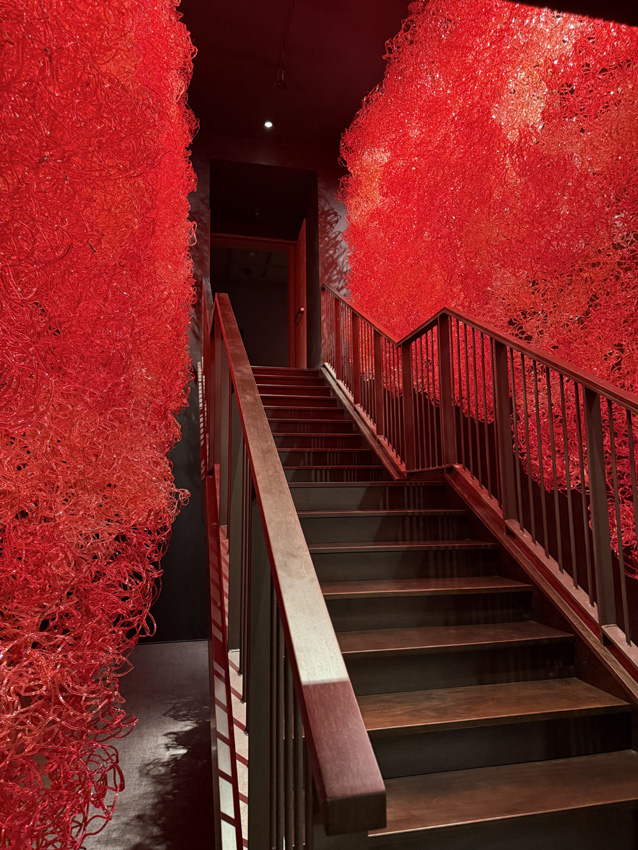
NOTE
[1] Si tratta di cronache in forma di resoconti come l’Historia Regum Britanniae,Storia dei re di Britannia, scritta in latino da Goffredo di Monmouth intorno al 1136, in seguito rivista e ritoccata dall’autore fino al 1147, ma soprattutto opere agiografiche, tra cui una Passio del X secolo.
[2] La vicenda è riportata in una lettera che proprio il Massa invia al Doria l’11 maggio 1610, in cui scrive: «Pensavo di mandarle il quadro di Sant’Orzola questa settimana però per assicurarmi di mandarlo ben asciuttato, lo posi al sole, che più presto ha fatto revenir la vernice che asciugatole per darcela il Caravaggio assai grossa: voglio di nuovo esser da detto Caravaggio per pigliar suo parere come si ha da fare perché non si guasti». Non è nota quale sia stata la successiva risposta del pittore.
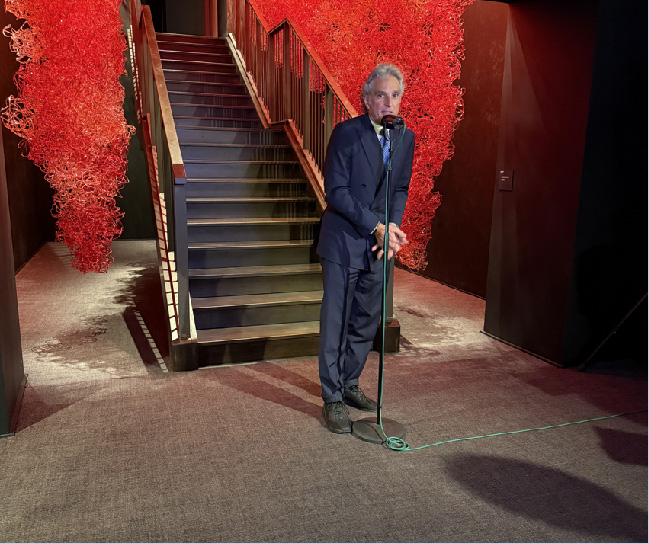
Michele Coppola, executive director art, culture and historical heritage of Intesa Sanpaolo and general director of the Gallerie d’Italia. In the other photos, the Caravaggio painting in its evocative setting, the golden tunnel and Jacopo Foggini’s striking red installation
The web of life cannot be understood while it is being woven only the final gaze gives it a name.
The martyrdom of the last Caravaggio
From August 1st, Caravaggio’s masterpiece “The Martyrdom of Saint Ursula” returns to the Gallerie d’Italia in Naples.
Life is like a painting: its meaning can only be fully grasped at the end. The complete understanding of existence, with all its experiences and their significance, is revealed over time—especially as one approaches its conclusion. Like a finished work of art, it can truly be appreciated only when seen in its entirety.
Caravaggio’s final work seems to embody this reflection, inviting us to meditate on several key aspects:
THE FACTOR OF TIME
Life is a dynamic process: events and experiences follow one another, transforming us. Only with age do we begin to recognize the connections, the lessons learned, and the overall meaning. What we have lived emerges more clearly in the way we act.
In The Martyrdom of Saint Ursula, time—usually a space for the research between awareness and knowledge—appears motionless. Opposites such as life and death, past and future, which normally chase one another in warm and cool tones, here are crystallized in the expectation of an uncertain future. Caravaggio longs for a future that remembers the past; Ursula for a testimony that synthesizes it; the Hun king for a future stripped of memory. If time is the art of relationships and awareness their unfolding, here reigns a motionless waiting, where the protagonists share the fate of their creator.
Caravaggio depicts the present moment with extraordinary effectiveness. His scenes capture fleeting moments, caught at the precise instant they occur. They are not static images, but sequences in motion, creating a sense of realism and immediacy.
This effect is achieved through:
- Light and shadow: the dramatic chiaroscuro creates contrasts that highlight the characters and their actions.
- Realism: breaking with academic tradition, he paints real subjects with natural expressions and poses.
- Dynamism: the scenes are charged with movement and tension, as if the characters were caught in full action.
- Theatrical space: the compositions appear set upon a stage, with vivid and engaging interactions.
In terms of temporality, another element is worth recalling: Caravaggio clothes his characters in contemporary garments—a revolutionary choice for the time. Thus, his works become immediate and relatable, breaking from the tradition that favored classical settings and idealized figures.
THE OVERALL VISION[1]
A work of art requires a comprehensive gaze to be understood. Details are important, but it is the composition-color, light, shadow-that provides depth and meaning. Likewise in life: events gain significance only in the context of an entire existence.
The story of Saint Ursula, suspended between historical truth and sacred imagination, is told in medieval texts that often contradict one another1. Ursula-Ursula in Latin meaning “little she-bear”-is a young woman of exceptional beauty, daughter of King Dionotus of Dumnonia in the southwest of Britain. Secretly consecrated to God, she is sought in marriage by the pagan prince Conan Meriadoc. To avoid conflict, an angel appears to her in a dream and advises her to write to her suitor, requesting three years of delay to discern God’s will and hope for his conversion.
At the end of this period, once again guided by a divine messenger, Ursula sets out with a fleet of eleven ships and 11,000 virgin handmaidens-and, according to some versions, her betrothed as well. She sails along the Rhine, stops in Cologne, reaches Basel, and finally makes a pilgrimage on foot to Rome. On the return journey to her homeland, the procession once again passes through Cologne, by then conquered by the Huns. The eleven thousand virgins, encouraged by Ursula to remain steadfast, are slaughtered by the barbarians’ fury in a single day-October 21st. The Hun king, enamored of Ursula, offers to spare her life in exchange for her consent. Upon her refusal, he pierces her with an arrow.
Hagiographic sources blend historical facts and legend. In particular, there are doubts about Ursula’s origins, the identity of the pope, the actual number of virgins, and even her supposed connection to Attila, to whom reference is often made. There is no historical link between the two, nor any evidence that Attila ever visited Cologne.
The painting by Caravaggio depicts the climactic moment of Ursula’s killing, just after being struck by the Hun king’s arrow.
Unlike traditional iconography, which portrays her with the symbols of martyrdom or surrounded by her slain companions, Caravaggio chooses to represent her earthly death, stripped of any overt references to sanctity.
The Hun king, having just released the arrow from his bow, wears a furrowed expression of surprise—perhaps even remorse—in an unexpected flash of humanity. Ursula inclines her head toward the wound, as if to examine what has just struck her. he figures emerge from the darkness through a masterfully orchestrated interplay of light and shadow, with the saint caught in a searing white radiance that sharpens and lays bare her agony.
Caravaggio received the commission from Marcantonio Doria, aristocrat and collector, son of Agostino Doria, the 83rd Doge of the Republic of Genoa, through Lanfranco Massa, the family’s agent in Naples. The choice of subject was linked to the family’s devotion to Saint Ursula and to the fact that Marcantonio’s stepdaughter, Anna Grimaldi, had taken vows at the Neapolitan convent of Sant’Andrea delle Dame, assuming the name Orsola.
The patron’s pressing demands led Massa to request delivery of the canvas before the varnish had fully dried, as noted in a letter dated May 11, 1610[2]. In that same letter, he records the astonishment the work aroused among its first viewers.
Completed in May 1610 and shipped to Genoa on the 27th of that month, the painting appears in Marcantonio’s posthumous inventory of 1620. It later passed to his son Nicolò, Prince of Angri and Duke of Eboli. In 1832 it was moved to the family palace in Santo Spirito, Naples, where two poorly executed restorations compromised its condition.
In 1973 the work was sold to the Banca Commerciale Italiana and initially attributed to Bartolomeo Manfredi, according to Roberto Longhi, or to Mattia Preti, according to Raffaello Causa. It was only in the 1980s, following the discovery of Massa’s letter and other documents in the Doria D’Angri archive, that the attribution to Caravaggio was definitively confirmed.
With subsequent bank mergers, the painting became part of the Intesa Sanpaolo collection. It was displayed for years at Palazzo Zevallos and, since 2021, in the new Palazzo Piacentini in Naples.
THE COMPLEXITY OF LIFE
Life is rarely linear or predictable. It is composed of joys and sorrows, successes and failures. Every experience, whether positive or negative, contributes to shaping one’s identity and understanding of the world. Only at the end can we see how all these elements fit together to create a unique story.
Over time, the Martyrdom of Saint Ursula seems to reveal not only its artistic content but also the existential truths that Caravaggio wove into the work.
During the 2003–2004 restorations, what was thought to be a pentimento emerged: a hand interposed between the saint and her executioner—interpreted as an attempt to halt the killing—and a tent in the background suggesting an interior setting within the Hun king’s camp.
It was the most recent cleaning and conservation work, carried out for the loan to the Caravaggio 2025 exhibition, that brought to light previously unseen details, restoring the painting’s original authenticity and making it closer to Caravaggio’s hand.
Restorers Laura Cibrario and Fabiola Jatta, working in the Gallerie d’Italia’s conservation lab in Naples, restored brightness and clarity to the work. Using the results of an X-ray analysis conducted by the Metropolitan Museum in 2017, Cibrario outlined the discoveries: three figures lost over time and several new details. To the right of the Hun king, the tip of a soldier’s nose and the outline of his helmet reappeared, along with a face previously invisible; the pilgrim’s face, once only suggested, was defined more clearly, especially his moustache and mouth. The central hand was confirmed to be his, thanks to the dark green of the arm, matching his cloak. Also rediscovered were the profile of a helmet behind Ursula, the bowstring, and a metal pouch on the belt.
The scene, set beneath a tent, now appears more crowded: seven figures in total, including Caravaggio himself. According to Cibrario, the artist appears as an observer, neither judging nor intervening. His sallow complexion suggests poor health. The image resembles a film still—a scene of violence involving Spanish soldiers, like those Caravaggio might have witnessed in seventeenth-century Naples. It is not only Ursula’s martyrdom: it is an ordinary episode of violence and death, common in that era. Caravaggio himself had been a victim—assaulted, disfigured, and likely ill. That pallor may reflect both his physical state and his inner turmoil.
Regarding Caravaggio’s posture in the painting, Antonio Ernesto Denunzio, Deputy Director of the Gallerie d’Italia in Naples, cites a prominent Caravaggio scholar who interprets his astonished expression and fixed gaze toward the point of death as a sign of despair. He lacks the proud, harsh, slightly grim look of other self-portraits; instead, he contemplates the horror of a world he is about to leave. It is a reference to his condition, but also a message to his powerful patron and friend Marcantonio Doria, expressing his own struggle.
In his Neapolitan works, unlike those painted in Rome, there emerges a sense of submission to man’s tragic fate— a fatalism deeply rooted in Neapolitan culture, steeped in its history and worldview. Upon arriving in Naples, Caravaggio absorbed the life of the city and infused it into his paintings of that period. Even in his gaze, there is a sense of surrender.
Michele Coppola, Executive Director of Art, Culture and Historical Assets at Intesa Sanpaolo and General Director of the Gallerie d’Italia, recalled the institution’s commitment to safeguarding and enhancing such a significant work, presenting the new features marking its return.
After the golden tunnel—an architectural intuition by Michele De Lucchi, symbolizing the rebirth of the palace transformed into a museum—the visitor encounters Jacopo Foggini’s contemporary installation The cloud and the shadow. The work envelops the staircase to the first floor in a mass of “red clouds” created by the purplish reflections of polycarbonate, forming a suspended world that ushers the visitor into an “other” space, a prelude to the room dedicated to Merisi’s masterpiece: a meeting of ancient art and contemporary suggestion.
Ascending the staircase, a small window offers a preview of the redesigned room, equipped with a display and lighting scheme conceived to provoke a profound emotional experience. The work is now framed in a seventeenth-century-style frame designed to protect it from harmful environmental factors such as humidity, temperature, and light, ensuring its preservation over time.
In the Martyrdom of Saint Ursula we find not only the final depiction of the artist’s own features, but also the last image Caravaggio left of himself: a fixed, astonished gaze, that of a solitary man who seems to have lost contact even with the characters he himself created in the work.
Life is like a painting: its meaning can only be grasped at the end. And in this final pose, Merisi seems to remind us that—even then, and perhaps especially then—understanding remains elusive.
FOOTNOTES
[1]These are chronicles in the form of accounts, such as the Historia Regum Britanniae (The History of the Kings of Britain), written in Latin by Geoffrey of Monmouth around 1136 and later revised and reworked by the author until 1147, but above all hagiographic works, including a Passio from the 10th century.
[2] The episode is recorded in a letter that Massa himself sent to Doria on May 11, 1610, in which he wrote: “I was thinking of sending you the painting of Saint Ursula this week, but to make sure I sent it well dried, I placed it in the sun, which more quickly caused the varnish to bloom again rather than dry it, as Caravaggio had applied it quite thickly. I wish to consult once more with the said Caravaggio to take his opinion on what should be done so that it will not be damaged.” It is not known what the painter’s subsequent reply was.


